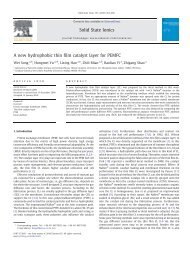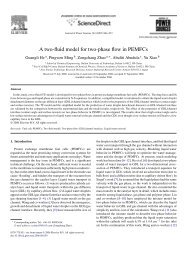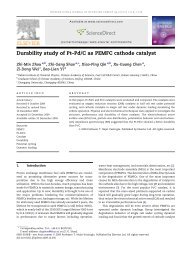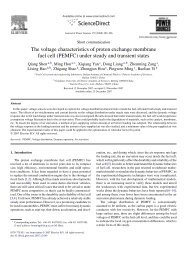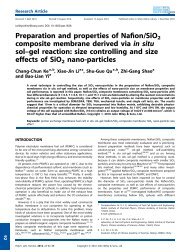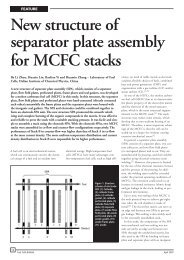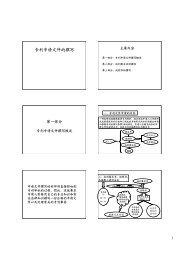Carbon-based films coated 316L stainless steel as bipolar plate for ...
Carbon-based films coated 316L stainless steel as bipolar plate for ...
Carbon-based films coated 316L stainless steel as bipolar plate for ...
Create successful ePaper yourself
Turn your PDF publications into a flip-book with our unique Google optimized e-Paper software.
international journal of hydrogen energy 34 (2009) 405–409<br />
Available at www.sciencedirect.com<br />
journal homepage: www.elsevier.com/locate/he<br />
Technical communication<br />
<strong>Carbon</strong>-<strong>b<strong>as</strong>ed</strong> <strong>films</strong> <strong>coated</strong> <strong>316L</strong> <strong>stainless</strong> <strong>steel</strong><br />
<strong>as</strong> <strong>bipolar</strong> <strong>plate</strong> <strong>for</strong> proton exchange membrane fuel cells<br />
Yu Fu a,c,d , Guoqiang Lin b , Ming Hou c, *,BoWu b , Zhigang Shao c , Baolian Yi c<br />
a Dalian Sunrise Power Co., LTD, Dalian 116025, China<br />
b Dalian University of Technology, Dalian 116024, China<br />
c Fuel Cell Laboratory, Dalian Institute of Chemical Physics, Chinese Academy of Sciences, Dalian 116023, China<br />
d Graduate University of Chinese Academy of Sciences, Beijing 100049, China<br />
article info<br />
Article history:<br />
Received 13 October 2008<br />
Accepted 21 October 2008<br />
Available online 26 November 2008<br />
Keywords:<br />
Metal <strong>bipolar</strong> <strong>plate</strong><br />
Surface treatment<br />
Pulsed bi<strong>as</strong> arc ion plating<br />
abstract<br />
<strong>Carbon</strong>-<strong>b<strong>as</strong>ed</strong> <strong>films</strong> on <strong>316L</strong> <strong>stainless</strong> <strong>steel</strong> were prepared <strong>as</strong> <strong>bipolar</strong> <strong>plate</strong>s <strong>for</strong> proton<br />
exchange membrane fuel cells (PEMFCs) by pulsed bi<strong>as</strong> arc ion plating. Three kinds of <strong>films</strong><br />
were <strong>for</strong>med including the pure C film, the C–Cr composite film and the C–Cr–N composite<br />
film. Interfacial conductivity of the <strong>bipolar</strong> <strong>plate</strong> with C–Cr film w<strong>as</strong> the highest, which<br />
showed great potential of application. Corrosion tests in simulated PEMFC environments<br />
revealed that the C–Cr film <strong>coated</strong> sample always showed better anticorrosive per<strong>for</strong>mance<br />
than <strong>316L</strong> <strong>stainless</strong> <strong>steel</strong> either in reducing or oxidizing environments. The C–Cr film <strong>coated</strong><br />
<strong>bipolar</strong> <strong>plate</strong> sample also had high surface energy. The contact angle of the C–Cr film <strong>coated</strong><br />
sample with water w<strong>as</strong> 92 , which is beneficial <strong>for</strong> water management in a fuel cell.<br />
ª 2008 International Association <strong>for</strong> Hydrogen Energy. Published by Elsevier Ltd. All rights<br />
reserved.<br />
1. Introduction<br />
The proton exchange membrane fuel cell (PEMFC) is an ideal<br />
candidate <strong>for</strong> automotive propulsion applications due to its<br />
high efficiency and near-zero emissions [1–3]. As a major part<br />
of the PEMFC stack, the <strong>bipolar</strong> <strong>plate</strong> accounts <strong>for</strong> most of the<br />
total weight and cost of the stack [4]. The <strong>bipolar</strong> <strong>plate</strong> serves<br />
<strong>as</strong> the following functions such <strong>as</strong> distributing reactants<br />
uni<strong>for</strong>mly over the active are<strong>as</strong>, removing heat from the active<br />
are<strong>as</strong>, carrying current from cells, preventing leakage of<br />
reactants and coolant etc. So the <strong>bipolar</strong> <strong>plate</strong> material should<br />
have the characteristics <strong>as</strong> follows: 1) high corrosion resistance<br />
in PEMFC environment; 2) low interfacial contact resistance;<br />
3) high surface tension with water; 4) lightweight; 5)<br />
high mechanical strength; 6) high volume cost-effective<br />
manufacturability etc.<br />
Two types of <strong>bipolar</strong> <strong>plate</strong> material are commercially<br />
available: graphite and metal [5]. Graphite is an ideal <strong>bipolar</strong><br />
<strong>plate</strong> material due to its high chemical stability and good<br />
electrical conductivity, but it is fragile to impact. What is<br />
more, <strong>for</strong>ming g<strong>as</strong> channels on graphite <strong>bipolar</strong> <strong>plate</strong> is<br />
usually a high cost course. So graphite is not suitable <strong>for</strong><br />
commercialization application directly. Metal such <strong>as</strong> the<br />
<strong>stainless</strong> <strong>steel</strong> is considered to be a good candidate material<br />
because of its high bulk electrical and heat conductivity, high<br />
strength, low g<strong>as</strong> permeability, and e<strong>as</strong>e of manufacture.<br />
However, the corrosion resistance and interfacial contact<br />
resistance of metal material should be considered. Forming<br />
* Corresponding author. Tel.: þ86 411 84379051; fax: þ86 411 84379185.<br />
E-mail address: houming@dicp.ac.cn (M. Hou).<br />
0360-3199/$ – see front matter ª 2008 International Association <strong>for</strong> Hydrogen Energy. Published by Elsevier Ltd. All rights reserved.<br />
doi:10.1016/j.ijhydene.2008.10.068
406<br />
international journal of hydrogen energy 34 (2009) 405–409<br />
Fig. 1 – Diagram of the PBAIP experimental setup.<br />
a protecting film with good corrosion resistance and high<br />
interfacial conductivity on <strong>stainless</strong> <strong>steel</strong> through surface<br />
treatment is one of the possible solutions [6–10].<br />
Some researches have been conducted on <strong>for</strong>ming carbon<br />
material film on metal <strong>bipolar</strong> <strong>plate</strong>. This kind of <strong>bipolar</strong> <strong>plate</strong><br />
could combine the advantages of the two materials. Show<br />
et al. [11,12] <strong>coated</strong> amorphous carbon film on Ti <strong>bipolar</strong> <strong>plate</strong><br />
at various growth temperatures. They found that the <strong>bipolar</strong><br />
<strong>plate</strong> showed a low contact resistance when the growth<br />
temperature incre<strong>as</strong>ed up to 600 C, and the fuel cell <strong>as</strong>sembled<br />
with this kind of <strong>bipolar</strong> <strong>plate</strong> showed an output power of<br />
1.4 times higher than that <strong>as</strong>sembled with the bare Ti <strong>bipolar</strong><br />
<strong>plate</strong>s. Fukutsuka et al. [13] prepared carbon coating on<br />
SUS304 using pl<strong>as</strong>ma-<strong>as</strong>sisted chemical vapor deposition. The<br />
corrosion resistance of the <strong>bipolar</strong> <strong>plate</strong>s w<strong>as</strong> improved in<br />
simulated PEMFC conditions, and the interfacial contact<br />
resistance w<strong>as</strong> also greatly reduced. Similar study w<strong>as</strong> also<br />
conducted by Chung et al. [14]. In addition, some patents are<br />
also <strong>as</strong>sociated with the technology of metal b<strong>as</strong>e/carbon<br />
coating <strong>bipolar</strong> <strong>plate</strong>s [15–17].<br />
In our study <strong>316L</strong> <strong>stainless</strong> <strong>steel</strong> substrates were <strong>coated</strong><br />
with carbon-<strong>b<strong>as</strong>ed</strong> <strong>films</strong> by pulsed bi<strong>as</strong> arc ion plating (PBAIP)<br />
to obtain protecting layers. PBAIP inherits the advantages of<br />
arc ion plating and brings in new features such <strong>as</strong> reduced<br />
droplets, dense <strong>films</strong> and low-temperature deposition. As<br />
a result, <strong>films</strong> with excellent per<strong>for</strong>mance can most likely be<br />
obtained. What is more, <strong>for</strong>ming film by PBAIP is an environment-friendly<br />
process. Compared with the Cr–nitride <strong>films</strong><br />
<strong>for</strong>med by PBAIP in our previous work [10], deposition of the<br />
carbon-<strong>b<strong>as</strong>ed</strong> film can be greatly accelerated, which is<br />
appropriate <strong>for</strong> commercial production. This is because that<br />
the carbon source can be induced by the carbon target and not<br />
from the atmosphere. In addition, the economical price of the<br />
carbon target is helpful to lower the <strong>bipolar</strong> <strong>plate</strong> cost.<br />
2. Experimental<br />
The PBAIP system used in this study is shown in Fig. 1. The<br />
<strong>316L</strong> <strong>stainless</strong> <strong>steel</strong> substrates with size of<br />
100 mm 100 mm 0.1 mm were ultr<strong>as</strong>onically cleaned in<br />
acetone, ethyl ethanol and deionized water <strong>for</strong> 15 min. Then<br />
they were blown dry and put on holders. The chamber w<strong>as</strong><br />
evacuated to a b<strong>as</strong>e pressure below 5.0 10 3 Pa using a turbo<br />
molecular pump and a rotary pump. Prior to the deposition,<br />
the substrates were sputtered by Ar ions to remove the<br />
p<strong>as</strong>sive film on the <strong>stainless</strong> <strong>steel</strong> surface. Then the carbon<strong>b<strong>as</strong>ed</strong><br />
<strong>films</strong> were deposited with the two targets work<br />
synchronously. Three kinds of <strong>films</strong> were <strong>for</strong>med in our study<br />
(Table 1). When <strong>for</strong>ming the pure carbon film, two carbon<br />
targets were used in a vacuum. As <strong>for</strong> the carbon-<strong>b<strong>as</strong>ed</strong> <strong>films</strong>,<br />
a chromium target and a carbon target were used; the deposition<br />
processes were in a high vacuum and in a N 2 atmosphere,<br />
respectively.<br />
In our setup (Fig. 2) <strong>for</strong> me<strong>as</strong>uring the contact resistance,<br />
two pieces of Toray carbon paper were sandwiched between<br />
the <strong>bipolar</strong> <strong>plate</strong> sample and two copper <strong>plate</strong>s which are<br />
<strong>plate</strong>d with gold on both sides to enhance conductivity. An<br />
electrical current of 5.0 A, sourced by a PSP-2010 Programmable<br />
power supply, w<strong>as</strong> provided through the copper <strong>plate</strong>s.<br />
During the tests, the compacting <strong>for</strong>ce w<strong>as</strong> incre<strong>as</strong>ed with<br />
5Ns 1 controlled by a WDW Electromechanical Universal<br />
Testing Machine. All the samples (including the <strong>bipolar</strong> <strong>plate</strong><br />
samples and the carbon papers) were wafers with diameter of<br />
60 mm which is the same size <strong>as</strong> the copper <strong>plate</strong>s.<br />
X-ray photoelectron spectrometer (XPS) w<strong>as</strong> used to characterize<br />
the coating.<br />
The corrosion behaviors of the <strong>bipolar</strong> <strong>plate</strong> samples were<br />
investigated in simulated PEMFC environments (0.5 M<br />
H 2 SO 4 þ 5 ppm F ) by electrochemical tests. The experiments<br />
were per<strong>for</strong>med at 25 C to simulate the environment when<br />
the stack power w<strong>as</strong> off and at 70 C to simulate the environment<br />
when the stack power w<strong>as</strong> on. The corrosion solution<br />
w<strong>as</strong> bubbled thoroughly with either hydrogen g<strong>as</strong> (<strong>for</strong><br />
Table 1 – Technologies of <strong>for</strong>ming the carbon-<strong>b<strong>as</strong>ed</strong> <strong>films</strong><br />
with PBAIP.<br />
Film type<br />
Target<br />
material<br />
Flow rate<br />
of N 2 (sccm)<br />
C <strong>Carbon</strong> 0<br />
C–Cr <strong>Carbon</strong> and Cr 0<br />
C–Cr–N <strong>Carbon</strong> and Cr 20
international journal of hydrogen energy 34 (2009) 405–409 407<br />
Table 2 – Composition of the composite coating by PABIP<br />
on <strong>316L</strong> <strong>stainless</strong> <strong>steel</strong>.<br />
Element Content (At, %)<br />
C 68.2<br />
Cr 17.1<br />
O 14.7<br />
Fig. 2 – Diagram of the setup <strong>for</strong> me<strong>as</strong>uring the interfacial<br />
contact resistance.<br />
simulating a PEMFC anodic environment) or pressured air (<strong>for</strong><br />
simulating a PEMFC cathodic environment) prior to and<br />
during the electrochemical me<strong>as</strong>urements. The samples were<br />
stabilized at open circuit potential <strong>for</strong> 30 min, then the<br />
potential w<strong>as</strong> swept at a scanning rate of 2 mV s 1 .<br />
At l<strong>as</strong>t, contact angle of the <strong>bipolar</strong> <strong>plate</strong> sample with water<br />
w<strong>as</strong> me<strong>as</strong>ured by a JC2000A Contact Angle Me<strong>as</strong>urement to<br />
investigate the surface energy. The contact angle of untreated<br />
<strong>316L</strong> <strong>stainless</strong> <strong>steel</strong> <strong>plate</strong> with water w<strong>as</strong> also me<strong>as</strong>ured <strong>for</strong><br />
comparison.<br />
3. Results and discussion<br />
3.1. Interfacial contact resistance<br />
Among all the requirements <strong>for</strong> the surface-treated metal<br />
<strong>bipolar</strong> <strong>plate</strong>s, the interfacial conductivity is the most important<br />
one. If the conductivity of <strong>bipolar</strong> <strong>plate</strong> material is not<br />
satisfied, high per<strong>for</strong>mance would not be obtained. For this<br />
re<strong>as</strong>on, interfacial contact resistances of the <strong>bipolar</strong> <strong>plate</strong><br />
samples with bare Toray carbon paper were used to screen the<br />
deposition technology. The interfacial contact resistances of<br />
the <strong>bipolar</strong> <strong>plate</strong> samples with Toray carbon paper are shown<br />
in Fig. 3. Among all the samples interfacial contact resistance<br />
of the pure C film w<strong>as</strong> 330–2160 mU cm 2 under 0.2–1.5 MPa,<br />
which w<strong>as</strong> the highest. The C–Cr–N film showed a better<br />
interfacial conductivity and the interfacial contact resistance<br />
w<strong>as</strong> 107–555 mU cm 2 under 0.2–1.5 MPa. But the <strong>bipolar</strong> <strong>plate</strong><br />
with C–Cr–N film could not satisfy the fuel cell application,<br />
too. As <strong>for</strong> the C–Cr film, it exhibited the best conductivity,<br />
which w<strong>as</strong> far lower than the other two. And the interfacial<br />
contact resistance of the C–Cr film w<strong>as</strong> only 6.86–8.72 mU cm 2<br />
under 0.2–1.5 MPa. So the <strong>316L</strong> <strong>stainless</strong> <strong>steel</strong> <strong>plate</strong> with C–Cr<br />
film w<strong>as</strong> chosen <strong>as</strong> candidate of <strong>bipolar</strong> <strong>plate</strong> <strong>for</strong> PEMFC.<br />
3.2. Characterization of the coating<br />
The XPS analysis result of the <strong>bipolar</strong> <strong>plate</strong> with C–Cr film is<br />
shown in Table 2. Over 68% C atom w<strong>as</strong> found in the coating,<br />
and the proportion of Cr and O is 17.1% and 14.7%, respectively.<br />
Obviously, the coating is mainly composed of carbon. As the<br />
coating process w<strong>as</strong> conducted under high vacuum, the<br />
oxygen w<strong>as</strong> very probably induced by surface adsorption when<br />
the sample w<strong>as</strong> exposed to the atmospheric environment.<br />
3.3. Corrosion resistance<br />
Potentiodynamic and potentiostatic tests were used to characterize<br />
corrosion resistance of the <strong>bipolar</strong> <strong>plate</strong> with C–Cr<br />
Fig. 3 – Contact resistance between the <strong>bipolar</strong> <strong>plate</strong><br />
samples with carbon-<strong>b<strong>as</strong>ed</strong> <strong>films</strong> <strong>for</strong>med by BPAIP with<br />
Toray carbon paper.<br />
Fig. 4 – Potentiodynamic curves of <strong>bipolar</strong> <strong>plate</strong> samples in<br />
0.5 M H 2 SO 4 D 5 ppm F L with a scan rate of 2 mV s L1 at<br />
25 8C.
408<br />
international journal of hydrogen energy 34 (2009) 405–409<br />
Fig. 5 – Potentiodynamic behaviors of <strong>bipolar</strong> <strong>plate</strong> samples<br />
in 0.5 M H 2 SO 4 D 5 ppm F L with a scan rate of 2 mV s L1 at<br />
70 8C bubbled with air.<br />
film. Potentiodynamic polarization curves of the <strong>bipolar</strong> <strong>plate</strong><br />
sample and untreated <strong>316L</strong> <strong>stainless</strong> <strong>steel</strong> in 0.5 M<br />
H 2 SO 4 þ 5 ppm F solution at 25 C (<strong>for</strong> simulate the environment<br />
when the stack power w<strong>as</strong> off) are shown in Fig. 4. The<br />
<strong>coated</strong> <strong>bipolar</strong> <strong>plate</strong> sample w<strong>as</strong> in p<strong>as</strong>sive state under test<br />
condition from 0.1 V to 0.8 V versus SCE. And the untreated<br />
<strong>316L</strong> <strong>stainless</strong> <strong>steel</strong> could be p<strong>as</strong>sivated spontaneously under<br />
the same condition from 0.2 V to 0.8 V versus SCE. The<br />
corrosion current densities of <strong>bipolar</strong> <strong>plate</strong> sample and <strong>316L</strong><br />
<strong>stainless</strong> <strong>steel</strong> were about 10 7 Acm 2 and 10 5 Acm 2 ,<br />
respectively. The <strong>coated</strong> <strong>bipolar</strong> <strong>plate</strong> sample exhibited much<br />
better corrosion resistance, in accordance with the result of<br />
the corrosion potential experiment. As <strong>for</strong> the experiments in<br />
0.5 M H 2 SO 4 þ 5 ppm F solution at 70 C (<strong>for</strong> simulate the<br />
environment when the stack power w<strong>as</strong> on) bubbled with air<br />
(Fig. 5) orH 2 (Fig. 6), the corrosion currents were higher than<br />
that per<strong>for</strong>med at 25 C. But the <strong>bipolar</strong> <strong>plate</strong> sample exhibited<br />
Fig. 7 – Contact angle of the <strong>coated</strong> <strong>bipolar</strong> <strong>plate</strong> with water.<br />
a better corrosion resistance than the b<strong>as</strong>e metal in all simulated<br />
PEMFC environments.<br />
3.4. Contact angle<br />
The contact angles of the <strong>bipolar</strong> <strong>plate</strong> with C–Cr film and <strong>316L</strong><br />
<strong>stainless</strong> <strong>steel</strong> with water are shown in Figs. 7 and 8, respectively.<br />
Obviously, the <strong>bipolar</strong> <strong>plate</strong> sample <strong>coated</strong> with C–Cr<br />
film h<strong>as</strong> a bigger contact angle (91 ) than <strong>316L</strong> <strong>stainless</strong> <strong>steel</strong><br />
(73 ). As we know, the process in fuel cell is always accompanied<br />
with water. To prevent the proton exchange<br />
membrane from dehydration, the inlet g<strong>as</strong>es need to be<br />
humidified. In addition, there exists water generated due to<br />
oxygen reduction reaction in the fuel cell stack, so the <strong>bipolar</strong><br />
<strong>plate</strong>s are often contacted with the mixture of reactant g<strong>as</strong><br />
and water. If the liquid water could not be removed in time,<br />
the water would block the reactant g<strong>as</strong>es accessing to the<br />
electrode. The accumulated water induces the electrode<br />
flooding phenomenon. Furthermore, the water adhering on<br />
the surface of <strong>bipolar</strong> <strong>plate</strong> accelerates the corrosion of metal<br />
<strong>bipolar</strong> <strong>plate</strong>. For these re<strong>as</strong>ons, this kind of <strong>bipolar</strong> <strong>plate</strong> with<br />
Fig. 6 – Potentiodynamic behaviors of <strong>bipolar</strong> <strong>plate</strong> samples<br />
in 0.5 M H 2 SO 4 D 5 ppm F L with a scan rate of 2 mV s L1 at<br />
70 8C bubbled with H 2 .<br />
Fig. 8 – Contact angle of the untreated <strong>316L</strong> <strong>stainless</strong> <strong>steel</strong><br />
<strong>plate</strong> with water.
international journal of hydrogen energy 34 (2009) 405–409 409<br />
high surface energy would be helpful <strong>for</strong> water removal in the<br />
stack and beneficial to the water management.<br />
4. Conclusion<br />
<strong>Carbon</strong>-<strong>b<strong>as</strong>ed</strong> <strong>films</strong> on <strong>316L</strong> <strong>stainless</strong> <strong>steel</strong> substrates were<br />
prepared by PBAIP <strong>as</strong> <strong>bipolar</strong> <strong>plate</strong> material <strong>for</strong> PEMFCs.<br />
Interfacial conductivity of the <strong>bipolar</strong> <strong>plate</strong>s with pure C film<br />
or with C–Cr–N film is not satisfied, but the <strong>bipolar</strong> <strong>plate</strong> with<br />
C–Cr film showed very low interfacial contact resistance.<br />
Potentiodynamic and potentiostatic tests conducted in<br />
simulated PEMFC environments also revealed that the corrosion<br />
resistance of <strong>bipolar</strong> <strong>plate</strong> sample with C–Cr film w<strong>as</strong><br />
greatly enhanced compared with the substrate. What is more,<br />
the contact angle of the sample with water w<strong>as</strong> higher, which<br />
is beneficial <strong>for</strong> water management in fuel cell. It is concluded<br />
that the <strong>316L</strong> <strong>stainless</strong> <strong>steel</strong> substrate with C–Cr film might be<br />
a good candidate <strong>for</strong> <strong>bipolar</strong> <strong>plate</strong> <strong>for</strong> PEMFC.<br />
Acknowledgments<br />
This work w<strong>as</strong> financially supported by the National High<br />
Technology Research and Development Program of China (863<br />
Program, No. 2007AA03Z221).<br />
references<br />
[1] Yi BL. Fuel cell-theory$technology$application. Beijing; 2003.<br />
p. 160–1.<br />
[2] Chalk SG, Patil PG, Venkateswaran SR. The new generation of<br />
vehicles: market opportunities <strong>for</strong> fuel cells. J Power Sources<br />
1996;61(1-2):7–13.<br />
[3] Hodgson DR, May B, Adcock PL, Davies DP. New lightweight<br />
<strong>bipolar</strong> <strong>plate</strong> system <strong>for</strong> polymer electrolyte membrane fuel<br />
cells. J Power Sources 2001;96(1):233–5.<br />
[4] Tsuchiya H, Kobay<strong>as</strong>hi O. M<strong>as</strong>s production cost of PEM fuel<br />
cell by learning curve. Int J Hydrogen Energy 2004;<br />
29(10):985–90.<br />
[5] Mehta V, Cooper JS. Review and analysis of PEM fuel cell<br />
design and manufacturing. J Power Sources 2003;<br />
114(1):32–53.<br />
[6] Cho EA, Jeon US, Hong SA, Oh IH, Kang SG. Per<strong>for</strong>mance of<br />
a 1 kW-cl<strong>as</strong>s PEMFC stack using TiN-<strong>coated</strong> 316 <strong>stainless</strong><br />
<strong>steel</strong> <strong>bipolar</strong> <strong>plate</strong>s. J Power Sources 2005;142(1–2):177–83.<br />
[7] Brady MP, Weisbrod K, Paulausk<strong>as</strong> I, Buchanan RA, More KL,<br />
Wang H, et al. Preferential thermal nitridation to <strong>for</strong>m pinhole<br />
free Cr–nitrides to protect proton exchange membrane<br />
fuel cell metallic <strong>bipolar</strong> <strong>plate</strong>s. Scripta Mater 2004;50(7):<br />
1017–22.<br />
[8] Paulausk<strong>as</strong> IE, Brady MP, Meyer III HM, Buchanan RA,<br />
Walker LR. Corrosion behavior of CrN, Cr 2 N and p ph<strong>as</strong>e<br />
surfaces on nitrided Ni–50Cr <strong>for</strong> proton exchange membrane<br />
fuel cell <strong>bipolar</strong> <strong>plate</strong>s. Corros Sci 2006;48(10):3157–71.<br />
[9] Wang H, Brady MP, More KL, Meyer III HM, Turner JA.<br />
Thermally nitrided <strong>stainless</strong> <strong>steel</strong>s <strong>for</strong> polymer electrolyte<br />
membrane fuel cell <strong>bipolar</strong> <strong>plate</strong>s: part 2: beneficial<br />
modification of p<strong>as</strong>sive layer on AISI446. J Power Sources<br />
2004;138(1–2):79–85.<br />
[10] Fu Y, Hou M, Lin GQ, Hou JB, Shao ZG, Yi BL. Coated <strong>316L</strong><br />
<strong>stainless</strong> <strong>steel</strong> with Cr x N film <strong>as</strong> <strong>bipolar</strong> <strong>plate</strong> <strong>for</strong> PEMFC<br />
prepared by pulsed bi<strong>as</strong> arc ion plating. J Power Sources 2008;<br />
176(1):282–6.<br />
[11] Show Y. Electrically conductive amorphous carbon coating<br />
on metal <strong>bipolar</strong> <strong>plate</strong>s <strong>for</strong> PEFC. Surf Coat Technol 2007;<br />
202(4–7):1252–5.<br />
[12] Show Y, Miki M, Nakamura T. Incre<strong>as</strong>ed in output power<br />
from fuel cell used metal <strong>bipolar</strong> <strong>plate</strong> <strong>coated</strong> with a-C film.<br />
Diamond Relat Mater 2007;16(4–7):1159–61.<br />
[13] Fukutsuka T, Yamaguchi T, Miyano SI, Matsuo Y, Sugie Y,<br />
Ogumi Z. <strong>Carbon</strong>-<strong>coated</strong> <strong>stainless</strong> <strong>steel</strong> <strong>as</strong> PEFC <strong>bipolar</strong> <strong>plate</strong><br />
material. J Power Sources 2007;174(1):199–205.<br />
[14] Chung CY, Chen SK, Chiu PJ, Chang MH, Hung TT, Ko TH.<br />
<strong>Carbon</strong> film-<strong>coated</strong> 304 <strong>stainless</strong> <strong>steel</strong> <strong>as</strong> PEMFC <strong>bipolar</strong><br />
<strong>plate</strong>. J Power Sources 2008;176(1):276–81.<br />
[15] Iqbal Z, Nar<strong>as</strong>imhan D, Guiheen JV, Rehg T. Corrosion<br />
resistant <strong>coated</strong> fuel cell <strong>plate</strong> with graphite protective<br />
barrier and method of making the same. US Patent 6864007;<br />
2005.<br />
[16] Nakata H, Yokoi M, Onishi M, Aihara H, Murate M, Kaji Y.<br />
Fuel cell g<strong>as</strong> separator, manufacturing method thereof, and<br />
fuel cell. US Patent 6749959; 2004.<br />
[17] Seido M, Tomogi T, Yamanaka T. Composite laminate<br />
structures especially useful <strong>for</strong> automotive trim<br />
components, and methods and the layers employed to make<br />
the same. US Patent 6805959; 2004.



